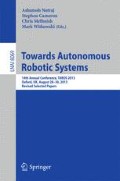Abstract
Unexpected obstacles pose significant challenges to mobile robot navigation. In this paper we investigate how, based on the assumption that unexpected obstacles really follow patterns that can be exploited, a mobile robot can learn the locations within an environment that are likely to contain obstacles, and so plan optimal paths by avoiding these locations in subsequent navigation tasks. We propose the DUNC (Dynamically Updating Navigational Confidence) method to do this. We evaluate the performance of the DUNC method by comparing it with existing methods in a large number of randomly generated simulated test environments. Our evaluations show that, by learning the likely locations of unexpected obstacles, the DUNC method can plan more efficient paths than existing approaches to this problem.
Access this chapter
Tax calculation will be finalised at checkout
Purchases are for personal use only
Notes
- 1.
In a Holms step-down procedure a statistically significant difference exists when the \(p\) value is less than the critical value.
References
Hu, H., Brady, M.: Dynamic global path planning with uncertainty for mobile robots in manufacturing. In: IEEE International Conference on Robotics and Automation, pp. 760–767 (1997)
Yamauchi, B., Beer, R.: Spatial learning for navigation in dynamic environments. IEEE Trans. Syst. Man Cybern. B Cybern. 26, 496–505 (1996)
Hsu, D., Latombe, J.C., Motwani, R.: Path planning in expansive configuration spaces. In: IEEE International Conference on Robotics and Automation (1997)
Phillips, B., Likhachev, M.: SIPP: safe interval path planning for dynamic environments. In: IEEE International Conference on Robotics and Automation, Shanghai, pp. 9–13 (2011)
Wang, T., Dang, Q., Pan, P.: Path planning approach in unknown environment. Int. J. Autom. Comput. 7, 310 (2010)
Hao, G., Zhang, D., Feng, X.: Model and algorithm for shortest path of multiple objectives. J. Southwest Jiaotong Univ. 42, 641–646 (2007)
Kulyukin, V., Kutiyanawala, A., LoPresti, E., Matthews, J., Simpson, R.: iWalker: toward a rollator-mounted wayfinding system for the elderly. In: IEEE International Conference on RFID (2008)
Murphy, L., Newman, P.: Planning most-likely paths from overhead imagery. In: IEEE International Conference on Robotics and Automation (ICRA) (2010)
Mathibela, B., Osborne, M.A., Posner, I., Newman, P.: Can priors be trusted? learning to anticipate roadworks. In: 15th International IEEE Conference on Intelligent Transportation Systems (ITSC) (2012)
Wolf, D.F., Sukhatme, G.S.: Mobile robot simultaneous localization and mapping in dynamic environments. J. Auton. Robot. 19, 53–65 (2005)
Koren, Y., Borenstein, J.: Potential field methods and their inherent limitations for mobile robot navigation. In: IEEE International Conference on Robotics and Automation (1991)
Baehoon, C., Beomseong, K., Euntai, K., Kwang-Woong, Y.: A modified dynamic window approach in crowded indoor environment for intelligent transport robot. In: International Conference on Control, Automation and Systems (2012)
Borenstein, J., Koren, Y.: The vector field histogram-fast obstacle avoidance for mobile robots. In: IEEE International Conference on Robotics and Automation, vol. 7, pp. 278–288 (1991)
Ding, F., Jiao, P., Bai, X., Wang, H.: AUV local path planning based on virtual potential field. In: IEEE International Conference on Mechatronics and Automation (2005)
Majdi, M., Anvar, H.S., Barzamini, R., Soleimanpour, S.: Multi AGV path planning in unknown environment using fuzzy inference systems. In: International Symposium on Communications, Control and Signal Processing (2008)
Stentz, A., Hebert, M.: A complete navigation system for goal acquisition in unknown environments. Auton. Robot. 2, 127–145 (1995)
Briggs, A.J., Detweiler, C., Scharstein, D., Vandenberg-rodes, A.: Expected shortest paths for landmark-based robot navigation. Int. J. Robot. Res. 23, 717–728 (2004)
Li, Y., Mac Namee, B., Kelleher, J.D.: Navigating the corridors of power: using RFID and compass sensors for robot localisation and navigation. In: The 11th Towards Autonomous Robotic Systems (TAROS 2010) (2010)
Edsger, W.D.: A note on two problems in connexion with graphs. Numer. Math. 1, 269–271 (1959)
Friedman, M.: A comparison of alternative tests of significance for the problem of m rankings. Ann. Math. Stat. 11, 86–92 (1940)
Holm, S.: A simple sequentially rejective multiple test procedure. Scand. J. Stat. 6, 65–70 (1979)
Author information
Authors and Affiliations
Corresponding authors
Editor information
Editors and Affiliations
Rights and permissions
Copyright information
© 2014 Springer-Verlag Berlin Heidelberg
About this paper
Cite this paper
Li, Y., Mac Namee, B., Kelleher, J. (2014). Expecting the Unexpected: Measure the Uncertainties for Mobile Robot Path Planning in Dynamic Environment. In: Natraj, A., Cameron, S., Melhuish, C., Witkowski, M. (eds) Towards Autonomous Robotic Systems. TAROS 2013. Lecture Notes in Computer Science(), vol 8069. Springer, Berlin, Heidelberg. https://doi.org/10.1007/978-3-662-43645-5_39
Download citation
DOI: https://doi.org/10.1007/978-3-662-43645-5_39
Published:
Publisher Name: Springer, Berlin, Heidelberg
Print ISBN: 978-3-662-43644-8
Online ISBN: 978-3-662-43645-5
eBook Packages: Computer ScienceComputer Science (R0)

